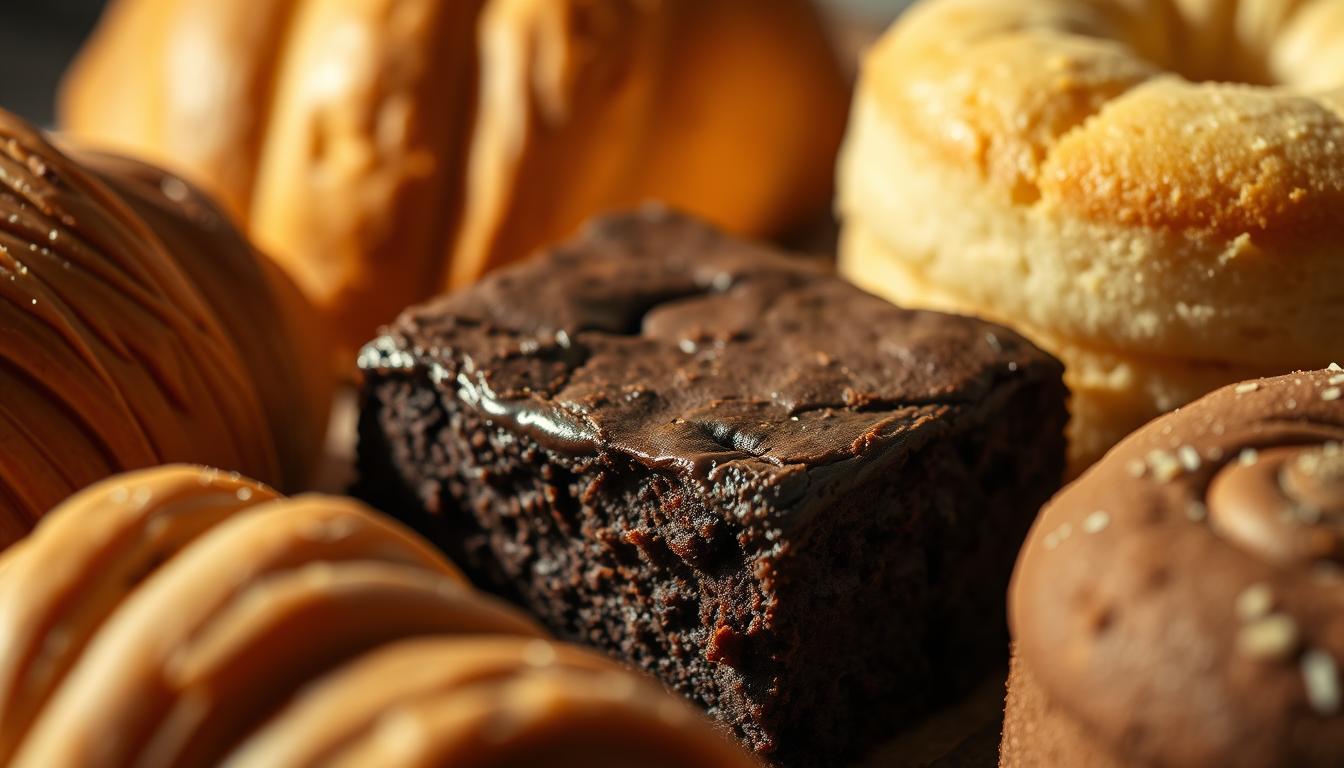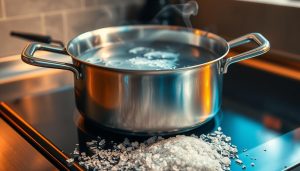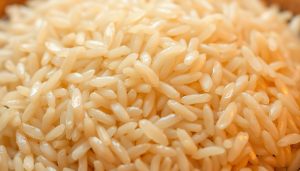Professional bakers use sugar in 93% of recipes not just for sweetness, but as a structural powerhouse. This kitchen staple controls crispness in cookies, softness in cakes, and even determines how long your muffins stay fresh. Its influence stretches far beyond flavor, shaping everything from crust formation to crumb density.
When heated, sugar undergoes chemical transformations that create golden-brown surfaces and tender interiors. It acts like a liquid during mixing, binding ingredients while simultaneously inhibiting gluten development. The right type and amount can mean the difference between chewy brownies and crumbly shortbread.
Different varieties produce unique effects. Coarse sugars create air pockets in meringues, while fine grains dissolve completely for uniform textures. Some forms attract moisture from the environment, keeping baked goods soft for days. Mastering these interactions lets you predict outcomes like a pastry chef.
Key Takeaways
- Sugar regulates moisture retention and shelf stability
- Crystalline structure impacts aeration capabilities
- Caramelization temperature affects crust formation
- Granule size determines dissolution rates
- Hydroscopic properties influence softness
- Chemical reactions modify gluten development
Introduction: The Multifunctional Role of Sugar in Baking
In professional kitchens, sugar operates as a silent architect behind your favorite treats. While sweetness gets the spotlight, its structural contributions define whether cookies snap or cakes collapse. When mixed with flour, it battles for water molecules – this competition weakens gluten networks, creating tender muffins instead of tough bread-like textures.

Ever wonder why pastries stay soft for days? Sugar acts like a moisture magnet, pulling water from the air into your baked goods. This humectant quality prevents staleness while maintaining chewiness in cookies and brownies. Bakers rely on this trait to extend freshness without artificial additives.
Heat transforms sugar into a color artist. At specific temperatures, it triggers Maillard reactions – the chemical process behind golden crusts on bread and rich hues in pie fillings. Simultaneously, it caramelizes to create complex flavors that plain starch can’t achieve.
Your mixing technique also benefits from sugar’s hidden talents. As you cream it with butter, sharp crystals carve air pockets into fat. These microscopic spaces expand during baking, giving lift to cakes and lightness to frostings. Master this interaction, and you’ll control rise and density like a pro.
Understanding Different Types of Sugar
Selecting the right sweetener transforms your baking results. Each variety brings unique properties that alter moisture levels, flavor depth, and structural integrity. Let’s examine how common options perform in recipes.
Granulated, Brown, and Specialty Sugars
Granulated sugar forms the backbone of most desserts. Its uniform crystals dissolve evenly, creating consistent textures. For chewier outcomes, reach for brown sugar – the molasses content adds moisture and caramel notes.
Specialty varieties solve specific challenges. C&H® Baker’s Sugar blends faster due to ultra-fine grains, while their powdered version prevents grittiness in icings. Dark brown types excel in spice-forward treats like gingerbread, where robust flavors shine.

Comparing C&H® and Domino® Sugar Options
Leading brands offer distinct profiles:
| Brand | Product | Key Feature | Best Use |
|---|---|---|---|
| C&H® | Dark Brown | Highest molasses | Rich desserts |
| C&H® | Baker’s Sugar | Finer crystals | Smooth batters |
| Domino® | Granulated | Precise measuring | Delicate cakes |
| Domino® | Dark Brown | Bold flavor | Oatmeal cookies |
Light brown sugars work well when you want subtle sweetness without overpowering other ingredients. Match your choice to the desired chewiness and flavor intensity.
How Sugar Affects Texture in Baking
Your cookie’s crunch or cake’s softness hinges on crystalline interactions you can’t see. Those tiny grains shape outcomes through three key mechanisms: moisture management, gluten interference, and air incorporation.

When creaming butter, sharp edges carve microscopic air pockets. These expand during heating, giving lift to pound cakes and fluffiness to frostings. Reduce the amount, and you’ll get denser results – like shortbread versus sponge cake.
In cookie dough, more white granules mean thinner, crisper treats. They absorb liquid during baking, slowing starch setting. Less sweetener? Your chocolate chips stay plump and chewy. It’s why bakery-style cookies often use brown varieties for soft centers.
The sweetener battles flour for water access. This competition weakens gluten strands, preventing tough muffins or bread-like cakes. Pastry chefs exploit this to balance chewiness with tenderness.
Moisture retention proves equally crucial. Hygroscopic properties pull humidity into treats, maintaining softness for days. That’s why properly stored banana bread stays fresh without preservatives.
- Higher concentrations create spread-out cookies with glass-like crispness
- Delayed protein binding ensures velvety cake crumbs
- Creaming technique determines final fluffiness
- Molasses-rich options extend softness duration
Sugar’s Role in Structure Formation
Baked goods achieve their signature textures through precise structural engineering. The sweetener you measure out does more than satisfy taste buds – it physically shapes your creations at molecular levels.
Impact on Gluten Development
When mixing batter, sugar acts like a hydration referee. It competes with flour proteins for available water, slowing gluten network formation. This controlled interference prevents dense, bread-like textures in delicate cakes.

- Reduces dough elasticity for tender crumbs
- Allows precise control over chewiness levels
- Prevents overdeveloped protein strands
Stabilizing Air Bubbles for Better Rise
During creaming, sugar crystals carve microscopic pockets in fat. These trapped air bubbles expand when heated, lifting batters upward. The sweetener’s crystalline edges reinforce cell walls, preventing premature collapse.
Sponge cakes demonstrate this principle perfectly. Their light structure depends on sugar maintaining foam integrity from mixing bowl to oven rack. Too little sweetener results in flat, dense layers.
Three critical stabilization effects occur:
- Enhanced volume through gas retention
- Uniform cell distribution for even rise
- Delayed starch gelatinization
Mastering these interactions lets you adjust recipes confidently. Swap granulated for brown sugar in cookies, and you’ll notice immediate changes in spread and softness – direct results of altered structural dynamics.
Moisture Retention Benefits from Sugar
Your baked treats stay fresh longer thanks to a natural ingredient you already use. The sweet crystals in your pantry work like invisible freshness guardians, locking in softness while delaying staleness.

Hygroscopic properties allow sugar to attract and hold water molecules from its surroundings. This creates a protective moisture barrier within your creations. Cakes maintain their springy crumb, while cookies keep their chew for days instead of turning brittle.
Enhancing Shelf Life and Softness
Higher concentrations create self-preserving desserts. Molasses-rich brown varieties excel here – their sticky texture actively resists drying. Commercial bakeries rely on this science to ship products nationwide without artificial preservatives.
Three key benefits emerge:
- Slowed starch retrogradation prevents bread-like firmness
- Consistent hydration maintains ideal mouthfeel
- Reduced need for chemical additives in recipes
Proper storage amplifies these effects. Keep your banana bread wrapped at room temperature, and watch it stay moist for five days instead of two. This natural preservation system lets you enjoy homemade quality longer.
Enhancing Browning and Color Through Sugar
That golden crust on bread or rich amber hue in pie fillings isn’t accidental – it’s science in action. Two chemical processes transform your baked goods’ appearance and flavor: the Maillard reaction and caramelization. Both rely on sugar’s molecular behavior under heat, creating visual appeal and complex tastes.

Maillard Reaction Insights
This flavor-building phenomenon occurs when sugar interacts with proteins at temperatures between 280-330°F. Think of toast developing its crisp exterior – that’s the Maillard reaction at work. In cakes and cookies, it produces golden-brown surfaces while generating nutty, roasted aromas.
The Caramelization Process Explained
Heat sugar beyond 340°F, and molecules fracture into new compounds. This breakdown creates deeper hues – from light amber to mahogany – alongside buttery or toffee-like flavors. Professional pastry chefs use this process to add complexity to crème brûlée or flan.
Key factors influence these transformations:
- Higher concentrations accelerate browning
- Acidic ingredients lower caramelization temperatures
- Moisture levels affect reaction speed
Want predictable results? Monitor oven temperatures closely. A 25°F difference can shift outcomes from golden perfection to burnt bitterness. For deeper dives into these chemical processes, explore food science principles that explain heat’s role in cooking reactions.
Balancing these reactions lets you control visual appeal and taste. Reduce sugar slightly for paler macarons, or boost it for darker, crisper biscotti. Your recipes become canvases for edible artistry.
Sugar’s Influence on Leavening and Air Incorporation
Behind every light cake and airy cookie lies a hidden architect working overtime. When you cream butter and sweetener, crystalline edges carve microscopic tunnels in fat – the foundation for your baked goods’ final height. These trapped oxygen reservoirs expand during heating, lifting batters like invisible hot-air balloons.

The creaming method demonstrates this principle perfectly. Sharp sugar crystals act as tiny blades, slicing through dairy fats to create thousands of air cells. As your oven’s heat penetrates the batter, these pockets grow, producing the tender crumb you crave in layer cakes.
Yeast Activation and Air Pocket Formation
In yeast doughs, sugar becomes a fuel source for microbial activity. As microorganisms consume it, they release carbon dioxide gas – the driving force behind bread’s upward rise. This biological process explains why sweetened doughs often achieve greater volume than their unsweetened counterparts.
Chemical leaveners like baking soda benefit too. Sweeteners slow starch gelatinization, giving batters extra time to expand before setting. Your muffins rise taller, and sponge cakes maintain their delicate structure thanks to this delayed solidification.
- Creamed mixtures gain 30% more volume through proper aeration
- Yeast-fed doughs produce 2x more gas with adequate sugar
- Foam-based desserts require precise ratios for stability
Master these interactions, and you’ll solve common baking frustrations. Flat cookies transform into cloud-like confections, while dense breads become light and airy. The right balance turns recipes into reliable blueprints for success.
Flavor Enhancement and Balancing
Master bakers know a secret: your recipe’s success depends as much on flavor harmony as ingredient ratios. While sweetness gets attention, sugar’s true magic lies in transforming harsh notes into balanced profiles.

Softening Bitter Notes in Recipes
Dark chocolate brownies demonstrate this principle perfectly. Without adequate sweetener, cocoa’s natural bitterness dominates. The right amount creates rich depth while letting chocolate’s complexity shine through.
Fruit desserts benefit similarly. Tart lemon bars become crowd-pleasers when sugar tempers acidity. This balance creates the sweet-tangy contrast that keeps forks reaching for seconds.
| Sugar Type | Flavor Impact | Best Pairings |
|---|---|---|
| Granulated | Clean sweetness | Vanilla cakes |
| Light Brown | Caramel hints | Oatmeal cookies |
| Dark Brown | Molasses depth | Gingerbread |
| Powdered | Neutral base | Buttercream |
Spiced desserts gain dimension when sweeteners amplify warming notes. Cinnamon rolls taste richer because sugar caramelizes with the spice. Nutty flavors in almond cookies become more pronounced through careful sweetening.
Professional kitchens use this knowledge strategically. They might choose dark brown sugar in pecan pie to complement the nuts’ earthiness. Your home baking can achieve similar sophistication by matching sweetener profiles to key ingredients.
Tenderizing Effect of Sugar in Baked Goods
Creating melt-in-your-mouth textures requires precise timing. Sugar acts as a culinary conductor, orchestrating chemical delays that transform dense batters into featherlight confections. Its ability to alter ingredient interactions separates bakery-quality results from amateur attempts.
Mastering Starch and Protein Interactions
During baking, sweetener molecules bind water that would typically activate starch and gluten formation. This interference creates a critical delay – your cake structure sets only when leavening agents peak. The result? Maximum gas retention for superior rise and airy crumbs.
| Sugar Percentage | Texture Impact | Recipe Example |
|---|---|---|
| 20-25% | Dense crumb | Shortbread |
| 30-35% | Balanced chew | Muffins |
| 40%+ | Ultra-tender | Angel food cake |
Professional kitchens leverage this science. Pastry chefs reduce sugar slightly when creating pound cakes that need structural integrity. Increase it for soufflés requiring delicate collapse resistance.
Three key tenderizing mechanisms occur:
- Water redistribution slows starch gelatinization
- Protein coagulation delays create softer networks
- Extended rising time maximizes air bubble expansion
Adjust ratios carefully. Too little sweetener leads to tough, bread-like textures. Too much causes structural collapse. Find your recipe’s sweet spot through controlled experimentation.
Sugar’s Impact on Freezing Stability
Frozen desserts maintain their smooth texture because of a key ingredient’s hidden talent. Beyond sweetness, crystalline structures alter how ice forms during freezing. This process prevents gritty ice crystals in sorbet and keeps ice cream scoopable straight from the freezer.
Lower freezing points occur when sweetener molecules bond with water. These bonds slow solidification, creating smaller ice formations. Your homemade gelato stays creamy instead of turning rock-hard due to this scientific interaction.
Thawing stability matters too. Hydroscopic properties pull moisture back into baked goods during defrosting. Muffins retain their tender crumb after freezing because sugar redistributes water evenly through the structure.
Commercial bakeries leverage this science for quality control. Cookies shipped frozen arrive tasting fresh-baked thanks to precise sweetener ratios. Adjust your recipes by considering freezing needs – slightly higher amounts improve texture retention without overpowering flavors.



